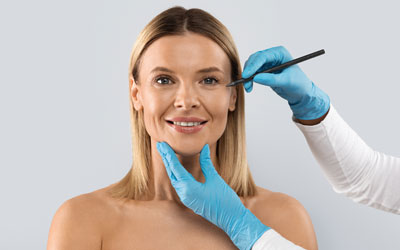

Eyelid surgery, also known as blepharoplasty, is a common procedure aimed at rejuvenating the appearance of the eyes by addressing issues such as sagging skin, puffiness, and wrinkles. However, when considering eyelid surgery, it’s essential to understand the differences between upper and lower eyelid surgery and determine which procedure is right for you.
What is Upper Eyelid Surgery?
Upper eyelid surgery focuses on correcting issues related to the upper eyelids, which can occur due to aging, genetics, or other factors. Here’s what upper eyelid surgery typically addresses:
- Sagging Skin: Over time, the skin on the upper eyelids can lose elasticity, leading to sagging or drooping. This not only affects your appearance, making you look tired or older, but can also obstruct your vision if the drooping is severe enough.
- Puffiness: Fat deposits can accumulate in the upper eyelids, creating a puffy appearance. This can contribute to a heavy or swollen look around the eyes.
- Excess Skin: In some cases, the excess skin may fold over the eyelid crease, causing a hooded appearance. This can make applying makeup challenging and may even interfere with vision.
What is Lower Eyelid Surgery?
Lower eyelid surgery targets the area beneath the eyes, addressing different concerns from those of the upper eyelids. Here’s what lower eyelid surgery typically addresses:
- Under-Eye Bags: Fatty deposits under the eyes can create noticeable bags, contributing to a tired or aged appearance. Lower eyelid surgery can remove or reposition this fat to create a smoother contour.
- Wrinkles and Fine Lines: The delicate skin under the eyes is prone to wrinkles and fine lines. Lower eyelid surgery can help tighten this skin, reducing the appearance of wrinkles.
- Dark Circles: While not always directly addressed by surgery, the reduction of puffiness and skin tightening can improve the appearance of dark circles by reducing shadows under the eyes.
Considerations When Deciding to Choose Between Upper or Lower Eyelid Surgery
Deciding between upper and lower eyelid surgery depends on your specific concerns and desired outcomes. Here’s a quick comparison to help you decide:
When considering eyelid surgery (blepharoplasty), it's important to evaluate which type of procedure—upper or lower eyelid surgery—best suits your needs. Here are the key considerations to guide your decision:
- Specific Concerns
- Upper Eyelid Surgery is typically chosen to correct drooping or sagging upper eyelids, which can impair vision or give a tired appearance. It’s ideal for those experiencing excess skin or fat deposits that cause hooded eyelids.
- Lower Eyelid Surgery is aimed at reducing puffiness, under-eye bags, or sagging skin below the eyes. This procedure is beneficial if you're concerned about a tired, aged appearance due to bags or wrinkles.
- Aesthetic Goals
- If your goal is to open up your eyes, making them look more youthful and alert, upper eyelid surgery may be appropriate.
- If your focus is on improving the smoothness and contour of the under-eye area, lower eyelid surgery might be the better choice.
- Functional vs. Cosmetic Needs
- Upper eyelid surgery can sometimes be medically necessary if drooping lids interfere with vision.
- Lower eyelid surgery is almost always performed for cosmetic reasons to improve appearance and facial harmony.
- Age-Related Changes
- Upper eyelids often experience drooping due to age-related loss of skin elasticity. In contrast, the lower eyelids typically develop puffiness and wrinkles due to fat protrusion and loss of skin tone.
What is Combination Eyelid Surgery?
Combination eyelid surgery refers to a procedure that involves addressing both the upper and lower eyelids in a single surgery. This dual approach is designed for individuals who have concerns with sagging upper eyelids and puffiness or wrinkles under the eyes, aiming to achieve a more balanced, refreshed, and youthful appearance.
Key Benefits of Combination Eyelid Surgery:
Comprehensive Rejuvenation - By addressing both upper and lower eyelids at once, the procedure offers a more harmonious and balanced facial rejuvenation, treating signs of aging in the entire eye area simultaneously.
Improved Aesthetic Results - Combining upper and lower blepharoplasty can lead to a more striking and youthful transformation, as it tackles all the major concerns around the eyes—drooping upper lids, under-eye bags, and excess skin—at once.
Single Recovery Period - One of the main advantages of combination surgery is that it allows patients to undergo only one recovery period. This means less overall downtime compared to having two separate procedures.
Cost Efficiency - Undergoing both surgeries together can also be more cost-effective compared to scheduling each procedure separately, as it typically reduces anesthesia and facility fees.
Possible Risks and Complications of Eyelid Surgery
While eyelid surgery is generally considered safe and has a high success rate, like any surgical procedure, it comes with potential risks and complications. Understanding these can help you make an informed decision and set realistic expectations for the outcome.
Bruising and Swelling
- Normal Side Effects: Bruising and swelling are common after eyelid surgery and typically subside within one to two weeks. Cold compresses and elevating the head can help reduce these effects.
- Prolonged Swelling: In some cases, swelling may last longer than usual, potentially leading to delayed healing.
Scarring
- Minimal and Well-Hidden: Scarring from eyelid surgery is usually minimal and well-hidden in the natural creases of the eyelids. However, in rare cases, scars may become more noticeable or raised.
- Hypertrophic or Keloid Scarring: Patients prone to excessive scarring (hypertrophic or keloid scars) should discuss this risk with their surgeon.
Infection
- Although it is rare, infection at the incision sites is still possible as with any other surgery. Plastic surgeons take precautions to minimise this risk, but it’s important to follow post-operative care instructions closely to avoid complications.
Bleeding
- Hematoma Formation: Excessive bleeding can lead to a hematoma, a collection of blood under the skin, which may require drainage. Hematomas are uncommon but may occur, particularly if post-operative care instructions aren’t followed.
Dry Eyes and Irritation
- Temporary Symptoms: Some patients may experience dry eyes, irritation, or an inability to close their eyes fully after surgery. These issues are usually temporary and resolve within a few days or weeks.
- Permanent Dryness: In very rare cases, persistent dryness or incomplete eyelid closure (lagophthalmos) may occur, leading to discomfort or the need for additional corrective surgery.
Asymmetry
- Minor Differences: Some patients may notice slight differences in the appearance of their eyelids after surgery, as no two sides of the face are perfectly symmetrical.
- Corrective Surgery: Significant asymmetry or unevenness may require revision surgery to correct.
Vision Changes
- Temporary Blurriness: Temporary blurred vision is a common side effect due to swelling or the use of ointments in the eyes during the recovery period. This typically resolves within a few days.
- Permanent Damage: Permanent vision changes, such as double vision or loss of sight, are extremely rare but possible, especially if complications like excessive bleeding or infection occur.
Ectropion or Entropion (Eyelid Malposition)
- Ectropion: This refers to the outward turning of the lower eyelid, which can lead to dryness and irritation of the eyes.
- Entropion: The inward turning of the eyelid can cause eyelashes to rub against the eye, leading to irritation. Both conditions may require additional corrective surgery if they occur.
Adverse Reaction to Anesthesia
- General Risks: Any surgery that involves anesthesia carries risks, such as allergic reactions or breathing problems. While these complications are rare, it’s important to discuss any previous reactions to anesthesia with your surgeon.
Suture Complications
- Suture Irritation: Occasionally, the sutures used during surgery can irritate the eye or surrounding skin, leading to discomfort or redness. This issue is usually minor and can be resolved with medication or by removing the sutures.
Minimising Risks
- Choosing a Qualified Plastic Surgeon: Selecting a board-certified plastic surgeon with extensive experience in blepharoplasty is one of the most effective ways to minimise risks.
- Following Post-Operative Care: Strictly adhering to aftercare instructions—such as using prescribed medications, avoiding strenuous activities, and protecting your eyes from the sun—can significantly reduce the likelihood of complications.
- Health Considerations: If you have any pre-existing health conditions, such as thyroid problems, high blood pressure, or diabetes, discuss these with your surgeon, as they may increase the risk of complications.
Deciding between upper and lower eyelid surgery—or whether you need both—depends on your unique facial anatomy and aesthetic goals. By understanding the differences between these procedures, you can make an informed decision that aligns with your needs.
If you’re considering eyelid surgery, we invite you to schedule a consultation with the team at SW1 Clinic. We’re here to help you explore your options and take the first step toward a refreshed, rejuvenated appearance.

FAMS (Plastic Surgery)

FAMS (Plastic Surgery)

Paragon
#13-01/2/3/4/5/6 Paragon
+65 6690 2471



